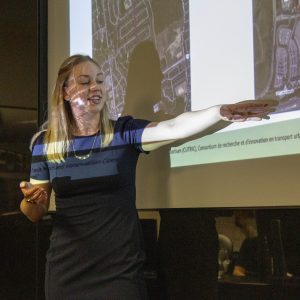
Kristina Mlakar, National Operations Manager and Project Lead at the Canadian Urban Transit Research and Innovation Consortium (CUTRIC) presented a seminar at U of T on April 26, 2019 entitled “CUTRIC National Smart Vehicle Demonstration & Integration Trial.” She was welcomed by a large audience.
The National Smart Vehicle Demonstration and Integration Trial aims to integrate fully autonomous, connected, low-speed, electrified shuttles (e-LSA) in up to 12 Canadian municipal jurisdictions as first-mile/last-mile applications. The project is currently in Phase 1 of 3, and the total estimated project cost is $30M to $40M.

Kristina talked about autonomous vehicles technologies and challenges, such as:
- low speeds
- lack of interaction with other road users
- large safety gap requirement
- poor localization and navigation technologies.
She also provided an overview of connected vehicle technologies and the pros and cons of each of them.

Kristina concluded that autonomous and connected vehicles technologies should be developed further before large scale adoption.
She believes that creating a data trust for providing free access to connected and autonomous vehicle data is needed. This can help universities and research centres to accelerate research in these technologies.
These are just a few points from Kristina’s presentation. For the full seminar, please see her presentation file or the videorecording:
Abstract
CUTRIC’s National Smart Vehicle Demonstration and Integration Trial will deploy electric automated shuttles in up to 12 municipalities across Canada as first-mile/last-mile transit applications.
The project involves three shuttle manufacturers – 2getthere, EasyMile and NAVYA – who have all agreed to standardize their systems as part of this deployment, representing a global first for multiple shuttle manufacturers deploying automated shuttles along the same route with standardized and interoperable systems.
The standardization focus of the project is:
- connected vehicle communication systems (vehicle-to-vehicle and vehicle-to-infrastructure);
- cybersecurity of e-LSAs and infrastructure;
- charging infrastructure; and
- e-LSA operating systems.
This talk will focus on the transit/city perspective regarding why cities are looking for OEMs to standardize their systems for interoperability and what the implications of standardization vs. non-standardization would be. I will also speak to the challenges of launching such a project, both technically and economically.
Kristina Mlakar is the National Operations Manager and Project Lead with the Canadian Urban Transit Research and Innovation Consortium (CUTRIC), based in Toronto. She manages the operations of CUTRIC’s fast-growing national team to effectively morph CUTRIC from a start-up organization into an increasingly successful small- to mid-sized enterprise (SME). Kristina was named as one of Corporate Knight’s Top 30 Under 30 Sustainability Leaders for her work with CUTRIC’s National Smart Vehicle Demonstration and Integration Trial. This project will represent a global first in the autonomous and connected vehicle space by deploying multi-manufacturer standardized autonomous and connected electric shuttles as enablers for first-mile/last-mile solutions in urban and suburban communities. Kristina completed her Master’s research paper on the State of Autonomous and Connected Vehicles in Canada. She previously worked as a Research Assistant with the McMaster Research Group for Stable Isotopologues and completed her undergraduate thesis in stable isotope geochemistry and paleoclimatology.
This seminar was presented by iCity-CATTS and the University of Toronto Institute of Transportation Engineers (ITE) Student Chapter.

